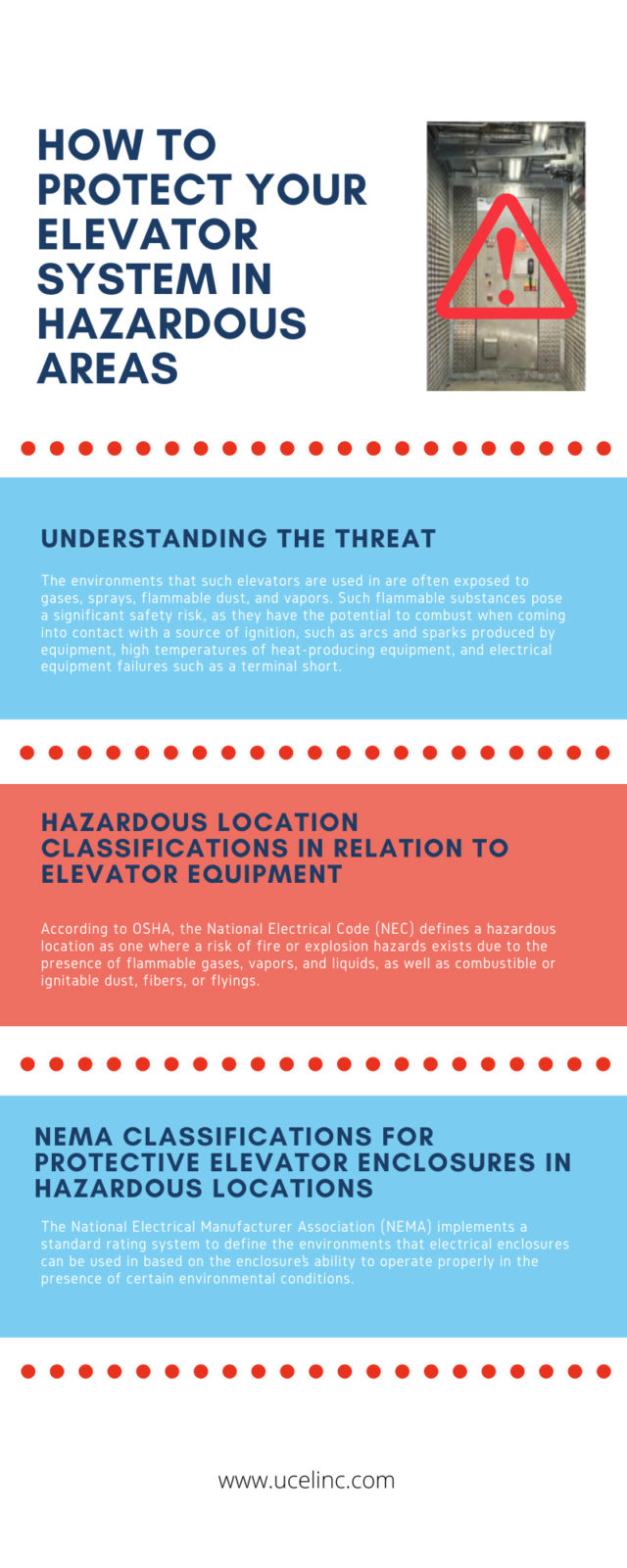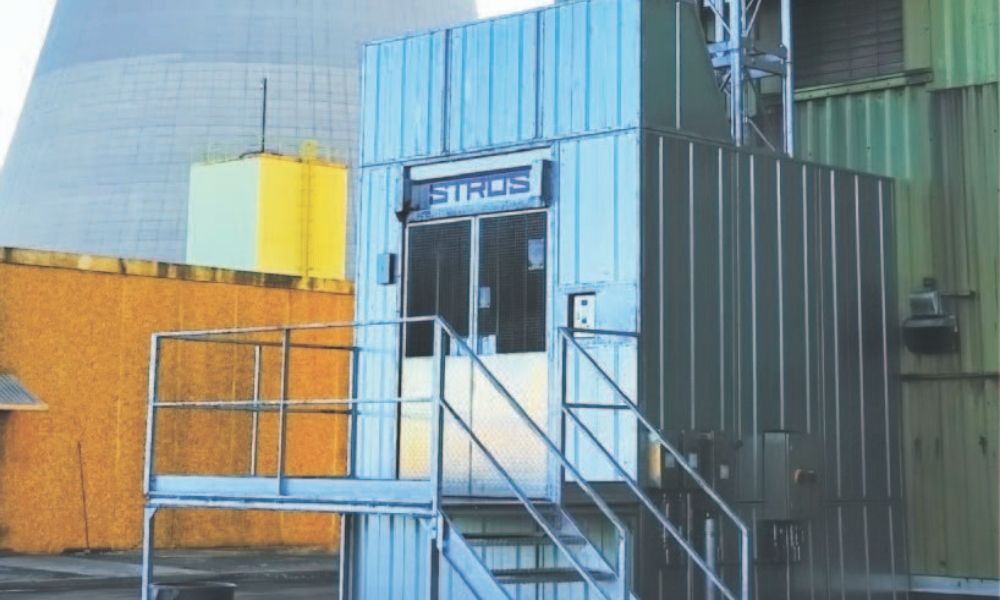Industrial elevators play a crucial role in the safe and efficient vertical transportation of personnel and materials on a job site. However, it’s important to recognize that those who engage in elevator work still face a wide variety of serious safety hazards—especially when such work is conducted in unforgiving environments that are at a higher risk of experiencing explosions. To mitigate the inherent dangers of elevator work, there is a large demand for elevator equipment and resources that will help protect against the safety risks faced in more hazardous operating locations. While the dangers of elevator work cannot be completely eliminated, these tips on how to protect your elevator system in hazardous areas will help create a safer and more stable work environment.
Understanding the Threat
Industrial elevators are implemented in a wide range of different industries—from natural gas production to cement manufacturing. The environments that such elevators are used in are often exposed to gases, sprays, flammable dusts, and vapors. Such flammable substances pose a significant safety risk, as they have the potential to combust when coming into contact with a source of ignition, such as arcs and sparks produced by equipment, high temperatures of heat-producing equipment, and electrical equipment failures such as a terminal short. In the case of an explosion, workers are at risk of severe injury and death.
That being said, flammable gases and dust aren’t the only hazards that elevators require protection from. Exposure to water and corrosive substances can also threaten the safe operation of elevator systems. Due to the many hazards that industrial elevator systems can be exposed to, it’s important to implement proper protective measures to ensure the safety of those who utilize them.
Hazardous Location Classifications in Relation To Elevator Equipment
In order to provide the appropriate level of elevator equipment protection, it’s essential to fully understand the threat that the operating location poses. To do so, one must familiarize themself with hazardous location classifications in relation to elevator equipment.
According to OSHA, the National Electrical Code (NEC) defines a hazardous location as one where a risk of fire or explosion hazards exists due to the presence of flammable gases, vapors, and liquids, as well as combustible or ignitable dust, fibers, or flyings. Below, we will address the various classifications of hazardous locations which vary based on the properties of the flammable substances present. By classifying your environment, you can better identify the type of protective equipment your elevator requires.
Class I Location
A Class I Location is an area where flammable gases or vapors are or may be present in high enough quantities to produce an explosion in the presence of an ignition source. Class I locations generally include gasoline storage and dispensing areas, petroleum refineries, aircraft fuel servicing areas, and utility gas plants.
Class II Location
A Class II Location refers to an area that includes the presence or potential presence of combustible metal, carbonaceous dust, or other combustible dust such as flour, grain, or wood in quantities that may be explosive or ignitable. Common Class II locations include flour and feed mills, grain elevators, and plants that manufacture plastics, magnesium powders, and starch.
Class III Area Classification
A Class III Location is an area that includes the presence of easily ignitable fibers or flyings that generally aren’t suspended in the air in sufficient quantities to be explosive or ignitable. Instead, they typically collect around machinery, on lighting fixtures, or other areas where they have the potential to ignite from sparks or heat. Common Class III locations include textile mills, lumber mills, or flax processing plants.
Division I and II Classifications
The above classifications can also be categorized into two different subdivisions: division I and division II. These divisions specify whether the hazards outlined in the classification are always present or only exist in certain situations:
- Division 1: An area where ignitable or combustible gases, vapors, and dust may be present under normal operating conditions.
- Division 2: An area where ignitable or combustible gases, vapors, and dust, are usually handled, processed, or otherwise used in the confines of closed systems or adequately dispersed by mechanical ventilation. Hazards in Division 2 areas typically present themselves as a result of accidents such as equipment failures or system ruptures.
NEMA Classifications for Protective Elevator Enclosures in Hazardous Locations
One of the primary methods for protecting elevator systems in hazardous environments is equipping them with a protective enclosure. The National Electrical Manufacturer Association (NEMA) implements a standard rating system to define the environments that electrical enclosures can be used in based on the enclosure’s ability to operate properly in the presence of certain environmental conditions. The following NEMA rating system for hazardous location types is based on the hazardous location classifications listed above. When choosing which enclosure will best protect your elevator system in a given hazardous area, it’s important to reference the NEMA rating system in order to select the most advantageous option for your application.
- Type 7: Enclosures created for use in indoor hazardous locations classified as Class I, Division 1. Such enclosures are designed to contain an internal explosion without creating an external hazard.
- Type 8: Enclosures created for both indoor and outdoor use in hazardous locations with a Class I, Division 1 classification. Such enclosures use equipment immersed in oil to prevent combustion.
- Type 9: Enclosures created for indoor use in hazardous locations with Class II, Division 1 classifications. Such enclosures are designed to prevent combustible dusts from igniting.
- Type 10: Enclosures created to satisfy Mine Safety and Health Administration requirements. They are designed to contain an internal explosion without facilitating an external hazard.
Additional Methods of Protecting Elevator Systems in Hazardous Environments
In addition to enclosures, there are also several additional ways to protect your elevator system in hazardous areas. Additional means of protection may include:
- Incorporating features that accommodate special emergency evacuation procedures
- Installing remote monitoring capabilities
- Implementing sealed piping
- Utilizing intrinsically safe circuits
If there is a potential for an ignition or explosion to occur, suitable hazardous location equipment should always be installed to ensure the safety of elevator workers. For this reason, UCEL’s industrial elevators are designed with special features to accommodate hazardous environments. In fact, we offer impressive explosion-proofing features for up to Class I, Division 2 locations. To learn more about how our specialized elevator systems can provide optimum protection in hazardous environments, contact us today.

